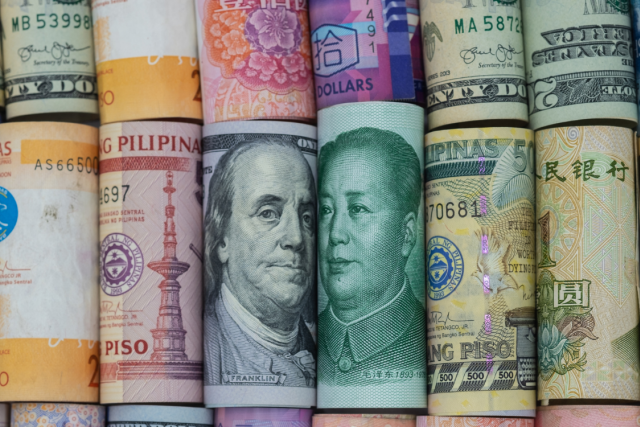With summer fading in the Northern Hemisphere and fall classes now upon us, we two Matts hope all our readers remain healthy and well as we pick up our pens again. As other work and life permits, we look forward to sharing our reflections in ways that hopefully illuminate and inspire. Today we comment on one of the most pressing problems facing the global economy: high, pervasive, and worrisomely persistent price inflation.
On December 23, 1972, in America’s National Football League, the Pittsburgh Steelers were losing their playoff game against the Oakland Raiders with only 22 seconds remaining. On fourth down with 10 yards to go for a first down, Steelers quarterback Terry Bradshaw threw a pass to receiver John “Frenchy” Fuqua. But the ball ricocheted into the air, either off the hands of Fuqua or off the helmet of Raiders defender Jack Tatum. Steelers running back Franco Harris snatched the falling ball just before it hit the turf and then sprinted 45 yards into the end zone.
The incensed Raiders argued that the ball had bounced off the hands of Fuqua, which would have ended the play. But the referees ruled the play a touchdown, and by the end of the day commentators and fans were decreeing it, with a nod to a central belief of the Catholic faith, “The Immaculate Reception.” Many have since argued that this play injected fresh resolve into the Steelers franchise, which had never before won a playoff game, and which rode the momentum from this victory to win the Super Bowl in 1975, 1976, 1979, and 1980. NFL Films and the NFL Network have selected the Immaculate Reception as the greatest NFL play of all time.
Today, the chair of the U.S. Federal Reserve, Jerome Powell, is trying to channel Terry Bradshaw and facilitate what a few commentators have aptly (though perhaps without full U.S. football knowledge) dubbed the Immaculate Disinflation.
In July, the U.S. Consumer Price Index had risen by 8.5 percent over the previous 12 months, down only slightly from the June year-over-year rise of 9.1 percent. All other such price indices show American prices rising at their fastest rate in at least 40 years. And in scores of other countries around the world, prices are now rising at similarly sobering levels. All this after Powell and so many of his colleagues on the Fed’s Federal Open Market Committee delivered lots of speeches last year and earlier this year explaining why the already-visible acceleration in U.S. prices might prove to be transitory—and thus why inflation would soon fall back to its Fed target of 2 percent.
So, what would be the Immaculate Disinflation? It would be the Fed wielding its powers to reduce U.S. inflation down to its 2 percent target without triggering a sustained reduction in employment, output, and other broad economic activities—that is, without triggering what is commonly referred to as a recession.
Just like Terry Bradshaw and the Steelers didn’t want to be losing to the Raiders with only 30 seconds to play nearly 50 years ago, Jay Powell and colleagues don’t want inflation to continue rising. But here we are. So, what would be the Immaculate Disinflation? It would be the Fed wielding its powers to reduce U.S. inflation down to its 2 percent target without triggering a sustained reduction in employment, output, and other broad economic activities—that is, without triggering what is commonly referred to as a recession.
There is a relatively simple explanation for U.S. prices rising so rapidly: aggregate demand for goods and services in America is much stronger than the aggregate supply of those goods and services. And there are three main explanations for the disconnect between aggregate supply and aggregate demand: the lingering pandemic-created kinks in global supply networks, the departure of so many Americans from the labor force, and the war in Ukraine impeding the flow of oil, natural gas, and many other commodities.
No central bank can magically conjure up more supply of goods and services. What the Fed can do is shape aggregate demand for those goods and services, by controlling the size and asset composition of its balance sheet—in particular, by setting the specific interest rate it can control, the effective federal funds interest rate, by varying the supply of what is commonly called high-powered money. The EFFR, or fed funds rate, is the interest rate that financial institutions belonging to the Federal Reserve System charge each other to lend and borrow reserves in excess of their legally mandated amount. Changes in the fed funds rate tend to feed through to changes in many other market interest rates faced by households and businesses that influence their consumption and investment decisions: e.g., mortgage rates and credit-card rates. In general, higher interest rates tend to curtail consumption and/or investment demand, which in turn tends to reduce aggregate demand through linkages such as rising unemployment, falling wages, and falling asset prices.
It was only on March 16, 2022—by which time the U.S. Consumer Price Index was known to be rising at an annual rate of 7.9 percent—that the Fed boosted its target fed funds rate above zero, which is where it had been since April 2020 (and had earlier been from late 2008 to early 2016). Since March, the Fed has raised the target fed funds rate three more times; today it stands in the range of 2.25 percent to 2.5 percent. And last Friday in Jackson Hole, Wyoming, in his much-anticipated speech at the annual symposium on economic policy organized by the Federal Reserve Bank of Kansas City, Powell told the world to expect more of the same:
Restoring price stability will take some time and requires using our tools forcefully to bring demand and supply into better balance. Reducing inflation is likely to require a sustained period of below-trend growth. Moreover, there will very likely be some softening of labor market conditions. While higher interest rates, slower growth, and softer labor market conditions will bring down inflation, they will also bring some pain to households and businesses. These are the unfortunate costs of reducing inflation. But a failure to restore price stability would mean far greater pain.
Will Powell’s efforts deliver an Immaculate Disinflation? Maybe. But as was the case for Terry Bradshaw 50 years ago, the odds of success are low. Since the 1950s, the U.S. economy has fallen into a recession within two years every time inflation has exceeded 4 percent and unemployment has fallen below 5 percent. This time might be different, but for that to happen there would need to be an Immaculate Reception–style miracle.
The U.S. government is currently estimating, based on available (and still-incoming) data, that U.S. gross domestic product—that is, the total output of goods and services produced in the U.S. economy—declined at an annual rate of 1.6 percent in the first quarter of 2022 and 0.6 percent in the second quarter. In turn, U.S. output has been contracting in large part because the growth rates for consumption demand and investment demand have decelerated. Consumption-demand growth that had been 7.9 percent for all of 2021 has decelerated to just 1.5 percent in second quarter 2022; investment-demand growth has similarly decelerated from 9.8 percent to −13.2 percent. It is precisely this deceleration of demand growth through which the Fed hopes to slow price growth.
But it has long been known that monetary policy works with long and variable lags. Nobel laureate Robert Solow once quipped that “Monetary policy is like driving a car along a winding road, when the car responds to the steering wheel with a lag that can range from 10 seconds to a minute or so.” In 2004, then-Fed-governor Ben Bernanke enriched Mr. Solow’s simile in the context of a speech on economic statistics by remarking that, “if making monetary policy is like driving a car, then the car is one that has an unreliable speedometer, a foggy windshield, and a tendency to respond unpredictably and with a delay to the accelerator or the brake.”
A fundamental reason for these lags is one of mismatched scale. Omniscient and omnipotent though the Fed may seem, its main policy tool of setting the fed funds rate affects households and businesses only indirectly, through capital-markets arbitrage. And there are a lot of households and businesses in America today: 122.4 million households in 2020, with a collective 164.0 million workers in the labor force as of July 2022, and 35.1 million businesses that filed a tax return with the Internal Revenue Service in the last year of available data (2015). When and by how much all those households, workers, and businesses respond to the Fed—its current policy stances and statements about its future policy actions—is impossible to predict with any precision.
So, although the Steelers’ Immaculate Reception took mere seconds, the Fed’s attempt at an Immaculate Disinflation will take many more months to play out.
So, although the Steelers’ Immaculate Reception took mere seconds, the Fed’s attempt at an Immaculate Disinflation will take many more months to play out. U.S. gross domestic income, a parallel statistical concept that, in principle, should equal gross domestic product, has expanded by 1.6 percent in the first half of 2022. And the U.S. labor market remains quite strong on all historical measures. Unemployment stands at just 3.5 percent. For every unemployed worker, there are still about two job vacancies. And wages, as well as broader measures of total compensation, are all rising at an annual rate of over 5 percent, which is well above the Fed’s 2 percent inflation target and which matters because labor accounts for about two-thirds of total costs in the U.S. economy. The fed funds rate needs to rise a lot more to restore price stability.
No one welcomes the painful trade-off of a deteriorating labor market and business environment that tighter Fed monetary policy entails. But “winning” at economic policy is rarely the unalloyed joy that comes from winning in sport, because economic policy often entails trade-offs. Yes, we all love a strong labor market. But unchecked excess labor demand tends to feed into inflation in a way that erodes the inflation-adjusted income of all workers. Indeed, real average weekly earnings for all U.S. workers fell by 3.6 percent from July 2021 to July 2022.
Terry Bradshaw needed skill, composure, and a bit of luck to pull off the Immaculate Reception. The same will be true for Jay Powell. Stay tuned.

